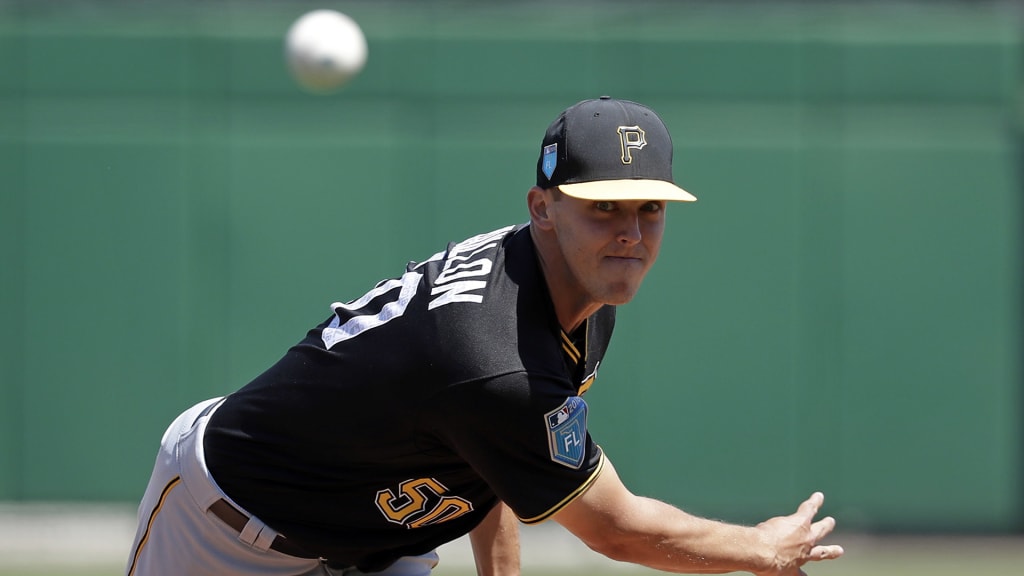
BRADENTON, Fla. -- Jameson Taillon never really had a chance to work on his slider last year. He introduced the pitch on the fly, a little more than a month into the season, even though he hadn’t thrown it since high school. But he has an idea of what it should look like.
Taillon throws a firm fastball and a big, slow curveball. He wants his slider to be a hard offering, something that moves more like a cutter and clocks in between 88-92 mph. This spring, the Pirates are using technology to help Taillon turn his vision into a pitch that helps him take another step forward.
Like many other teams this spring, the Pirates have ramped up their use of high-speed cameras and tracking technology. Take a look around Pirate City and you’ll find Rapsodo units sending data to tablets on the field during batting practice, high-speed cameras in the bullpen and a bunch of players eager to use that information to their benefit.
“It gives us objective data on what we see. This technology provides feedback for the player to really believe what you’re saying and what you’re seeing,” assistant pitching coach Justin Meccage said. “The cool part about it is it’s instant. We can do something about it right now.
"This day and age, players want the truth. This gives you the truth.”
Take Taillon, for instance. While throwing a bullpen session last week, he noticed some unusual movement on his slider. He liked what he saw, and he wanted to understand the reason behind it. That bullpen was being tracked by a Rapsodo unit sitting between the mound and home plate, so Taillon could dig into the numbers in search of an explanation.
Rapsodo tracks all kinds of information for pitchers, including velocity, location, spin rate, spin axis, vertical break, horizontal break and release point. The cameras capture slow-motion video, which is ideal for analyzing the nuances of a pitcher’s delivery.
“You can take it as far as you want,” Taillon said. “If during one bullpen my slider’s really hard and I liked it, I can go back and say, ‘OK, let’s see the data behind that. Why was it harder? What did it look like? What was I doing differently?’ It’s a fun process of talking with the pitching coaches and the catchers and everybody involved.”
And it takes a “whole crew” to do it, Taillon said. Pitching coach Ray Searage and Meccage typically huddle with pitchers, catchers and Aaron Razum, the Major League advance coordinator in the Pirates’ baseball informatics group, to break down the data and video.
“It’s awesome. It’s definitely very informative,” starter Trevor Williams said. “How you use it is completely up to the player. … What are you holding merit in? Is it your spin rate, vertical break, horizontal break, extension? What makes that information imperative to your success?”
Williams doesn’t have overwhelming velocity, but he can beat hitters with deception and pinpoint command. Last season, especially during his dominant second half, opponents noted that it seemed like all of Williams’ pitches blended together. So the right-hander might dive into the data to examine the trajectory of his pitches, looking for offerings that complement or disguise each other.
It’s a valuable tool from a coaching perspective, too, because Searage and Meccage can use the Rapsodo data or slow-motion footage to confirm what they’re seeing on the mound and support their case for recommending a change.
“It’s all about getting the players to buy in,” Meccage said, “and that buy-in process is shorter now.”
All 30 Major League organizations are employing some form of pitch-tracking technology this spring, and 28 are using Rapsodo. The Pirates introduced Rapsodo at the Major League level to track bullpen sessions last season. The system records information on each pitch, creating instant feedback that can be particularly useful when developing a pitch the way that Taillon is now with his slider.
“I like to experiment with stuff,” Taillon said. “I’m kind of at a point where I feel like I can.
“You watch the best starters in the league, they’re good every time out. This kind of stuff can help create that consistency. It’s putting numbers behind, ‘Why was I good today? What do I need to do next start to be good? What pitch plays off of which pitch best?’ There’s not as many variables. I’m looking to create that with my pitches, with my routine, in the weight room, with my diet. By the end of the day, you have everything real locked in. That’s what I’m trying to get.”


